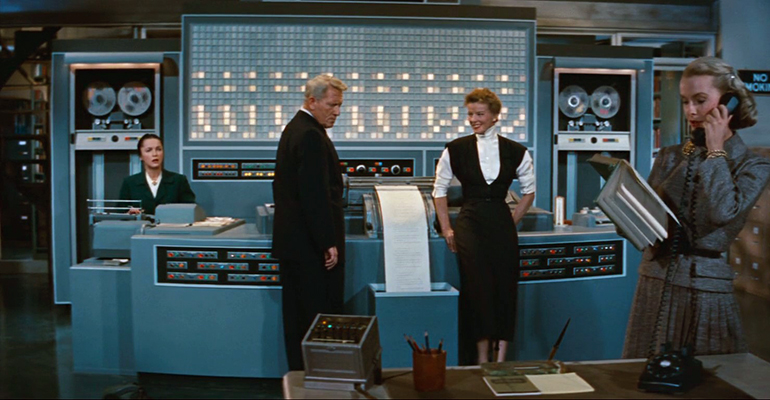The artificially-intelligent EMERAC from IBM is a remarkable piece of computer hardware. Roughly the size of a Winnebago campervan and emitting a constant hum of sci-fi bleeps and bloops, the computer can answer nearly any question put to it. Using the teletype input, you can ask it about the total weight of the Earth or the dollar amount of damage done annually to America’s forests by the spruce budworm, then watch your answer spool out instantly from the dot matrix printer. Most remarkable, this computer can be found not on the deck of the Starship Enterprise, but in the reference library of the Federal Broadcasting Network in Midtown Manhattan.
EMERAC (“Electromagnetic MEmory and Research Arithmetical Calculator”) drives the plot of the 1957 romantic comedy Desk Set, starring the legendary duo of Katherine Hepburn and Spencer Tracy. Hepburn plays Bunny Watson, the whip-smart but hopelessly single head librarian of the network. Tracy plays Richard Sumner, the engineer and efficiency expert hired to automate her department. Sparks fly, often literally, as they flirtatiously spar over the future of the library. Nicknamed “Emmy” (like a great-grandmother to Siri and Alexa), EMERAC plays the role of the other woman, threatening to derail Bunny and Richard’s budding romance. The film’s portrayal of knowledge workers facing the loss of their jobs to artificial intelligence feels prescient, but the story ends on a tech-friendly note. Rather than replacing human librarians, it’s revealed EMERAC was designed only to augment their capabilities as the library expands.
Watching the film nearly 70 years on, Desk Set plays as both wildly ahead of its time and quaintly retro. In our post-internet age, libraries tend to be portrayed as stodgy, archaic institutions, far more concerned with the past than the future. But as Desk Set reminds us, they have historically been on the cutting edge of technological change. From microfilm and electric checkout to pneumatic tube systems and computerized catalogues, libraries have long been sites of innovation for new tech. As the world went online during the late 20th Century, public libraries offered an early gateway to the internet, and they remain a critical provider of online services to disadvantaged communities. Modern libraries aren’t just musty repositories for old books, but dynamic, highly-networked systems for managing flows of information.
Ten years after Hepburn and Tracy faced off in Desk Set, the film’s future-forward message was echoed by a pair of real-life American archivists– Barbara Fisher from the Library of Congress and Frank Evans from the Office of the National Archives. In a bibliographic review of research on the digital automation of libraries, Fisher and Evans predicted transformative changes in the collection and storage of information. They called on their fellow archivists to acquaint themselves with cybernetics and cybernetic theory as a means to manage the future of technology in their field. They wrote:
The archivist or manuscript curator should regard himself less as a custodian of physical entities—record groups, personal papers, manuscript collections, and miscellanies—than as an information specialist. He will then find that he is able to bring sources to inquirers and inquirers to sources in ways made possible only by the technology of electronics.
Some might argue technology has made information specialists of us all, that advances in search and artificial intelligence have put EMERAC in our pockets, rendering the role of the librarian, and the library itself, obsolete. However, this couldn’t be further from the truth. We’re currently in the midst of a worldwide information crisis, adrift in a rising sea of conspiracy theories, culture war propaganda, junk science, and false advertising. Internet search has grown degraded and unreliable. Algorithms prioritize ‘engagement’ over truth and accuracy. Whatever their benefits, programs like ChatGPT threaten to flood the web with more spam and misinformation than ever before.
Against this backdrop, the library’s role as a trusted curator becomes increasingly vital. The stated mission of the National Library of Australia, to “collect today what will be important tomorrow”, has never been more urgent, or more challenging. The volume of information created since the start of 21st Century far exceeds that from the rest of history combined, and this trend only shows signs of accelerating. Going forward, we’ll need partnerships between archivists and engineers like Watson and Sumner, managing technological systems as powerful as EMERAC, to collect, preserve, and make accessible the knowledge on which our future will be built.
Read more in the AI and libraries series:
The age of artificially intelligent search The future of AI personas
